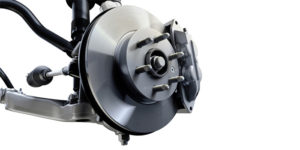 Brake rotors perform two essential tasks in the brake system: they provide a two-sided friction surface for the brake pads to rub against, and they absorb and dissipate heat. When the brakes are applied, hydraulic pressure pushes the caliper pistons out and forces the pads to rub against the rotors. This clamping action creates friction which generates heat as the vehicle slows. The rotors soak up and dissipate the heat, which prevents the linings from getting too hot (which would lead to increased pedal effort, brake fade and increased stopping distance).
Brake rotors perform two essential tasks in the brake system: they provide a two-sided friction surface for the brake pads to rub against, and they absorb and dissipate heat. When the brakes are applied, hydraulic pressure pushes the caliper pistons out and forces the pads to rub against the rotors. This clamping action creates friction which generates heat as the vehicle slows. The rotors soak up and dissipate the heat, which prevents the linings from getting too hot (which would lead to increased pedal effort, brake fade and increased stopping distance).
Rotors come in two basic varieties: “vented” and “solid.” Vented rotors have cooling fins cast between the faces of the rotor. This increases the overall thickness and weight of the rotor, but also greatly improves its ability to handle heat. Solid rotors have no cooling fins between the rotor faces. Vented rotors are used on front brakes while solid rotors are often used on rear brakes because the front brakes typically work harder and generate more heat than the rear brakes.
Most rotors are one-piece castings made of gray cast iron. But many late-model vehicles have “composite” brake rotors with a cast iron disc mated to a stamped steel center hat section. Composite rotors are about 20 percent lighter than ordinary rotors. Some also are “directional,” and are marked “left” and “right” depending on which side of the vehicle they fit.
Composite rotors are not as rigid as solid one-piece cast rotors, so they are more sensitive to vibration and runout issues. They also must be supported with large bell caps on a brake lathe if they are resurfaced to prevent runout or surface finish problems. Some technicians prefer to replace composite rotors with conventional one-piece cast rotors. However, if this is done, both rotors must be replaced at the same time.
When a vehicle’s brake pads need to be replaced, the rotors are often resurfaced or replaced at the same time to restore a like-new friction surface for the new pads. Rotors must be replaced if cracked or worn too thin. On every rotor is a “minimum thickness” or “discard” specification that must not be exceeded. If the rotor has worn down to the minimum spec or cannot be resurfaced without exceeding the spec, it must be replaced.
If the rotors are rough, but still thick enough to be reused, they can be resurfaced on a brake lathe or on-car lathe to restore a smooth, flat surface. Rotors should always be resurfaced in pairs. A nondirectional or crosshatch finish can help noise issues while the new pads are seating in to the rotors.
Rotors should be replaced if they have “hard spots” or uneven wear that is causing a noticeable pedal pulsation when the brakes are applied. New quality rotors are finished to OEM specifications and are ready to install out of the box. They should not require any additional machining. In fact, resurfacing a new rotor only reduces its useful service life, and may result in a rougher finish and/or runout problems.





